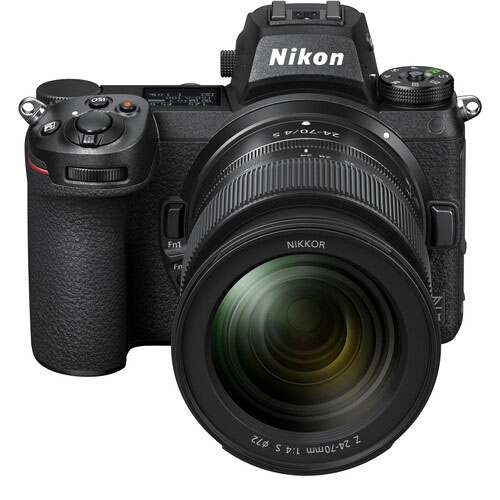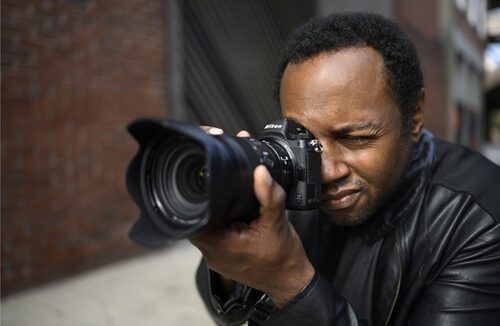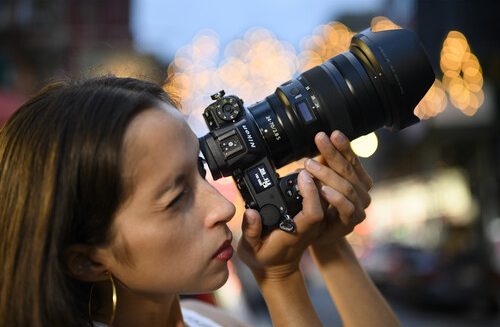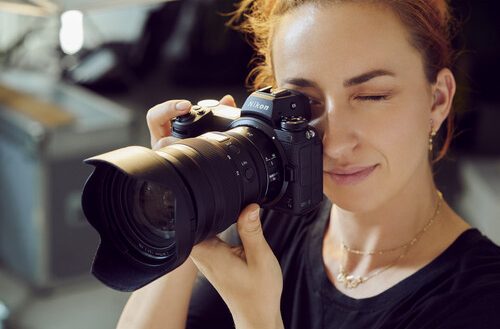Nikon Z7 II Design & Build

The Nikon Z7 II greets you with a solid magnesium-alloy body that balances ruggedness with portability. It’s weather-sealed across the frame, enabling confident use in dusty, damp, or cold conditions. You’ll feel the construction quality immediately when handling the camera.
Ergonomics remain a standout. Nikon has retained their deep, comfortable grip, and the physical placement of dials and buttons is practical and intuitive. In a long landscape shoot, your hand rarely tenses as the body stays under control.
Weight-wise, it’s lighter than many high-res DSLRs, yet it doesn’t feel fragile. It’s compact enough for travel, but dense enough to convey durability. Whether you’re trekking a canyon or shooting in studio, the Z7 II feels right in the hand.
Overall, the design reflects thoughtful engineering: tough materials, sensible layout, and a build that inspires confidence both in the field and under the lights.
Image Quality & Sensor
At the heart of the Nikon Z7 II sits a 45.7-megapixel back-illuminated full-frame CMOS sensor. That level of resolution captures extraordinary detail and subtleties—ideal for expansive landscapes, head-turning prints, or intricate product work. It’s also great for portraits, as Manny Ortiz discusses in the video above.
Nikon’s color science shines. File output feels natural: mid-tones are pleasing, skin tones feel genuine, and landscapes exhibit rich yet balanced saturation. The colors never scream—they simply feel true to life.
Dynamic range is another strong suit. In scenes with bright skies and deep shadows, you can recover detail on both ends of the spectrum with minimal noise. RAW processing reveals smooth gradations and wide tonal latitude, making post-editing a joy.
In low light, the camera holds up well. ISO performance stays respectable up to moderately high settings, with clean shadows and well-managed noise. If you value resolution over extremes in ISO speed, the Nikon Z7 II strikes a strong balance.
Autofocus Performance of the Nikon Z7 II

The autofocus system on the Nikon Z7 II uses a hybrid phase- and contrast-detection setup with 493 points covering much of the frame. This gives you flexibility in composition—subjects don’t need to be centered to stay sharp.
Eye-detection autofocus is highly reliable for both human and animal subjects. The system locks onto eyes quickly and keeps tracking even when your subject moves, making portrait and wildlife shooting smoother.
In low-light environments, autofocus retains speed and accuracy better than the original Z7. Continuous AF tracks movement with more predictability, though it’s best suited for moderate action rather than blazing-fast sports.
The overall feel is confident: the camera finds focus fast, keeps it locked, and rarely surprises you. For most professional use—portraits, events, landscapes, wildlife—it delivers solid focus performance.
Video Capabilities
The video feature set of the Nikon Z7 II is a step up for a stills-centric body. It shoots 4K UHD up to 60 frames per second, providing smooth footage and creative flexibility for slow motion or fast-paced scenes. See it in action in the video above by Taylor Jackson
It also supports 10-bit N-Log and HLG formats. Internal capture in 10-bit expands color depth for grading, while HDMI output enables external recorders or clean feeds for streaming setups—great for documentary or run-and-gun creators.
Rolling shutter is reduced compared to Nikon’s earlier mirrorless models, though it’s still perceptible in fast pans. In everyday use—interviews, short films, event documentation—the slight skew rarely becomes an issue.
Full-HD modes include 120 fps slow-motion options that hold up well in quality. Overall, the Z7 II covers a surprising range of video needs, making it a strong hybrid option for creators crossing between stills and motion.
Speed & Buffer Handling

The Nikon Z7 II offers up to 10 frames per second continuous shooting at full resolution—plenty for most decisive moment captures like wildlife bursts, street sequences, or fleeting expressions.
With dual EXPEED 6 processors under the hood, everything feels quick: startup is snappy, menu navigation is fluid, and shot-to-shot playback is smooth. The camera never feels like it’s lagging behind you.
Buffer performance is solid—but not unlimited. Shoot long sequences of RAW and you’ll eventually hit the buffer ceiling. Thankfully, pairing CFexpress or fast UHS-II cards helps clear it quickly. Still, it’s something to keep in mind in burst-heavy scenarios.
For most users, the speed and responsiveness suffice. Unless your work demands prolonged bursts—like pro sports coverage—this balance of resolution and speed works very well.
Ergonomics & Handling of the Nikon Z7 II

Handling the Nikon Z7 II is a refined experience. Buttons and dials are well-labeled, tactile, and intuitive. The body remembers where your thumb rests, keeping most key controls within easy reach.
The 3.69-million-dot electronic viewfinder is bright, sharp, and high resolution—it gives you a near-optical feel. The shutter blackout is minimal and the refresh rate keeps pace with your movements. Composing through the EVF is both accurate and immersive.
The 2.1-million-dot 3.2-inch rear tilting touchscreen is responsive and helpful for low or overhead angles. Touch focus and menu navigation add convenience, especially for users transitioning from DSLR touchbacks or those who shoot from awkward angles.
Dual memory card slots (one CFexpress/XQD, one UHS-II SD) cover both speed and redundancy. Battery performance using the EN-EL15c is solid; a full day of mixed shooting is common. Also, USB-C charging and power delivery simplify field use, travel, and tethering.
Storage & Battery Life

The dual-slot system is versatile: CFexpress/XQD gives serious speed for bursts, while UHS-II SD offers flexibility and affordability. You can record RAW files to one card, JPEGs to the other—or use backup and overflow modes for safety.
Battery life with the EN-EL15c is improved over previous models. Mixed-use sessions—combining EVF, video, and menus—still get you near a full day’s shooting. That’s a plus for events, on-location work, or shoots without frequent power access.
USB-C charging adds practicality. You can top up between shots using power banks or laptop ports. Some clever setups allow continuous power during tethered use—a big advantage for studio or wildlife setups.
Just bring a spare battery and fast card when shooting long-term. The Z7 II doesn’t reinvent the wheel here—but it delivers dependable performance with thoughtful, modern conveniences.
Connectivity & Extras

Built-in Wi-Fi and Bluetooth support wireless image transfer and remote control. Nikon’s SnapBridge app can pair your phone as a live view and remote, though mobile experience varies depending on environment. It’s solid for occasional control and quick previews.
Physical ports include full-size HDMI with 10-bit output, a headphone jack for audio monitoring, and a mic input for external audio. Those make the Nikon Z7 II flexible for both photo and video-centric setups in professional workflows.
Firmware updates are accessible and often include meaningful improvements—range from expanded lens compatibility to new features. This ensures your camera stays relevant and gains value over time.
Overall, the extras enhance functionality without cluttering the core experience—delivering practical tools for connectivity, monitoring, and growth.
Lens Ecosystem & Support for the Nikon Z7 II

The Nikon Z mount lens system continues to grow quickly. Nikon now offers an impressive range—from sharp primes to high-quality zooms—for nearly every genre: portraits, landscapes, macro, sports, and beyond. Native glass delivers excellent performance on the Z7 II sensor.
Backwards compatibility via the FTZ adapter gives you access to F-mount lenses already in your kit. Autofocus, VR, and metering work reliably through the adapter—so upgrading bodies, not lenses, can be your first step.
Third-party manufacturers like Sigma, Tamron, and Zeiss also offer Z-mount options, often with unique features or budget pricing. This expands your choices and adds further value to the system.
As the ecosystem matures, investing in a few quality lenses becomes wiser than expanding bodies. The Nikon Z7 II is just the start of a flexible, future-ready platform fueled by excellent optics.
Value & Buying Used

The Nikon Z7 II is a premium camera with a price to match. New, it’s geared toward professionals and serious enthusiasts seeking high resolution, build quality, and system maturity.
But buying used is a smart way to get the performance your budget deserves. Reputable sellers like MPB offer well-graded Nikon Z7 II bodies that include a thorough inspection, a six-month warranty, and a seven-day return window. That means you get value without surrendering peace of mind.
By buying a certified used Z7 II from MPB—or a similar trusted source—you can reinvest savings into essential lenses or accessories. That strengthens your full system rather than just the body.
In practice, a well-graded, used Nikon Z7 II performs almost identically to a new one. With inspection, warranty, and return protection in place, that path offers real value without compromising on capability.
Pros & Cons of the Nikon Z7 II
- Pros: Exceptional 45.7MP image quality; rich, natural color; wide dynamic range; reliable autofocus with eye tracking; strong 4K video options; intuitive ergonomics; dual card slots; excellent native and third-party lens support.
- Cons: RAW buffer fills with sustained bursts; not the fastest choice for pro-level sports; higher price point for new bodies.
Final Thoughts

The Nikon Z7 II is a refined mirrorless workhorse that blends the image-brilliance of a high-res sensor with meaningful enhancements in speed, autofocus, video, and handling. It’s not just an upgrade—it’s a thoughtful evolution built for real-world demands.
Whether you’re a landscape photographer, portrait artist, hybrid creator, or studio pro, the Z7 II provides top-tier files, ergonomic ease, and video readiness to match. It’s a camera that works hard while staying intuitive.
And if you choose the smart path—buying a trusted used unit—you get all that power without stretching your budget. That way, you can invest in the lenses and accessories that complete your creative toolkit.
In short, the Nikon Z7 II remains a standout in full-frame mirrorless, offering lasting value and capability, especially when paired with smart buying choices.
FAQ
Is the Nikon Z7 II still worth buying in 2025?
Absolutely. Its resolution, autofocus, video features, and system maturity keep it competitive. Buying used often offers exceptional value.
How much has autofocus improved over the original Z7?
Quite a bit. The Z7 II is noticeably faster and more responsive in low light and continuous AF, making tracking and focus acquisition more reliable.
Is 4K video on the Nikon Z7 II good enough for professional work?
Yes. It shoots 4K up to 60p, supports 10-bit N-Log and HLG, and offers clean HDMI output—solid tools for hybrid or video-focused professionals.
Should I consider buying a used Nikon Z7 II?
Definitely. Trusted platforms like MPB offer inspected bodies with warranties and return policies, giving you high performance at a smart price.
What lenses should new owners prioritize for the Nikon Z7 II?
Start with a versatile zoom (like 24-70 mm) and pair it with a fast prime (like 50 mm or 85 mm). Landscape shooters may favor high-quality wide zooms or ultrawides.
How long does the battery last on the Nikon Z7 II?
With the EN-EL15c battery, expect a full day of mixed-use shooting. USB-C charging adds flexibility in the field.
Heads up: Clicking on our affiliate links and exploring our sponsored content helps us at no extra cost to you, and we only recommend gear we’re absolutely crazy about!

